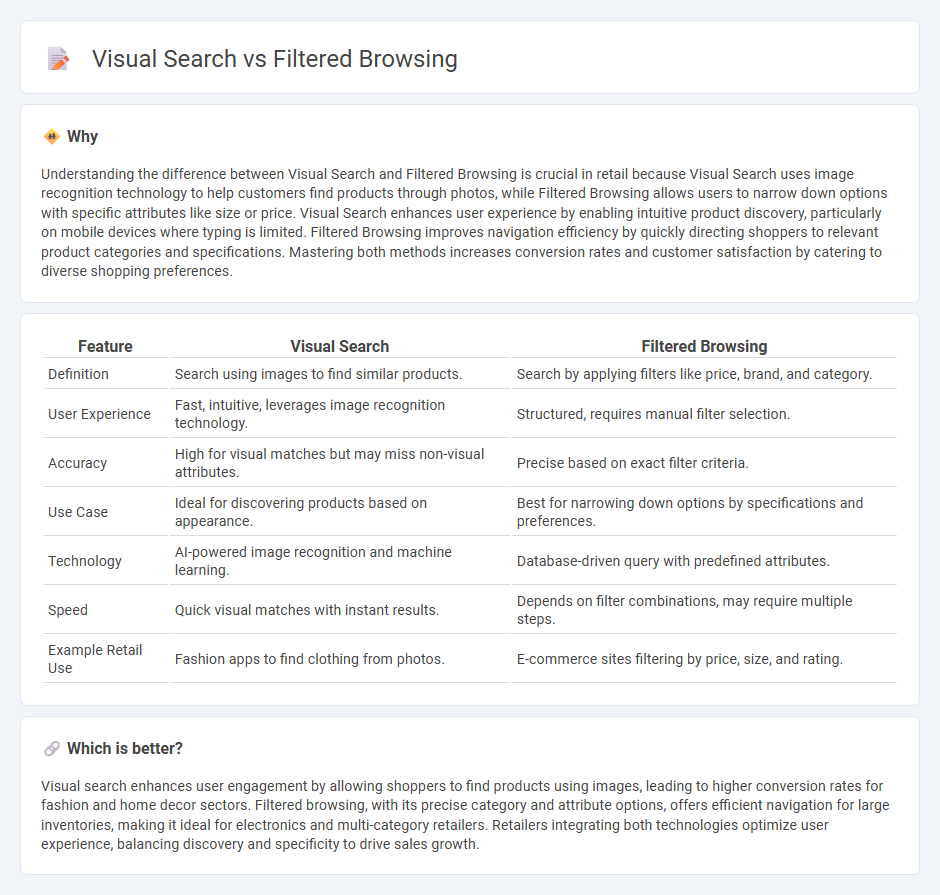
Visual search enhances retail experiences by allowing customers to find products using images, boosting engagement and accuracy, while filtered browsing streamlines product discovery through specific criteria such as price, brand, or category. Retailers leveraging visual search report increased conversion rates and customer satisfaction, whereas filtered browsing remains essential for users who prefer detailed, attribute-based navigation. Explore the unique benefits of both methods to transform your retail strategy effectively.
Why it is important
Understanding the difference between Visual Search and Filtered Browsing is crucial in retail because Visual Search uses image recognition technology to help customers find products through photos, while Filtered Browsing allows users to narrow down options with specific attributes like size or price. Visual Search enhances user experience by enabling intuitive product discovery, particularly on mobile devices where typing is limited. Filtered Browsing improves navigation efficiency by quickly directing shoppers to relevant product categories and specifications. Mastering both methods increases conversion rates and customer satisfaction by catering to diverse shopping preferences.
Comparison Table
| Feature | Visual Search | Filtered Browsing |
|---|---|---|
| Definition | Search using images to find similar products. | Search by applying filters like price, brand, and category. |
| User Experience | Fast, intuitive, leverages image recognition technology. | Structured, requires manual filter selection. |
| Accuracy | High for visual matches but may miss non-visual attributes. | Precise based on exact filter criteria. |
| Use Case | Ideal for discovering products based on appearance. | Best for narrowing down options by specifications and preferences. |
| Technology | AI-powered image recognition and machine learning. | Database-driven query with predefined attributes. |
| Speed | Quick visual matches with instant results. | Depends on filter combinations, may require multiple steps. |
| Example Retail Use | Fashion apps to find clothing from photos. | E-commerce sites filtering by price, size, and rating. |
Which is better?
Visual search enhances user engagement by allowing shoppers to find products using images, leading to higher conversion rates for fashion and home decor sectors. Filtered browsing, with its precise category and attribute options, offers efficient navigation for large inventories, making it ideal for electronics and multi-category retailers. Retailers integrating both technologies optimize user experience, balancing discovery and specificity to drive sales growth.
Connection
Visual search enhances retail by allowing customers to upload images and find matching products, streamlining the discovery process. Filtered browsing complements this by enabling users to narrow down visual search results using attributes such as color, size, and price range. Together, they improve user experience and increase conversion rates by combining intuitive image recognition with precise attribute-based filtering.
Key Terms
Product Discovery
Filtered browsing enhances product discovery by allowing users to apply specific criteria such as price range, brand, and ratings to narrow down large inventories efficiently. Visual search leverages image recognition technology to identify and recommend products based on photos, improving discovery for users with vague or unknown product names. Explore our comprehensive guide to learn how integrating both methods can optimize your product discovery experience.
Personalization
Filtered browsing leverages user preferences and behavioral data to tailor search results, enhancing the relevance of content based on individual interests and previous interactions. Visual search utilizes image recognition and AI to deliver personalized results by analyzing visual elements users provide, enabling discovery through direct visual input. Explore how combining these technologies can transform personalized user experiences in digital environments.
Image Recognition
Image recognition technology plays a crucial role in both filtered browsing and visual search by enabling accurate identification and categorization of images. Filtered browsing leverages image recognition to sort and display relevant visual content based on user-defined criteria, enhancing search precision. Discover how advancements in image recognition are transforming online search experiences by exploring these innovative technologies further.
Source and External Links
Internet filter - Wikipedia - Internet filtering is software that restricts internet access to certain content, implemented at various levels like network, DNS, or search engine filters, designed to block inappropriate or harmful material according to set policies.
Filter websites and searches using Microsoft Family Safety - Microsoft Family Safety provides web and search filters across Windows, Xbox, and mobile devices to block inappropriate websites and searches, customizable with allowed or blocked site lists and requiring use of Microsoft Edge browser with signed-in accounts.
Web Filter for Chrome - Chrome Web Store - Web Filter for Chrome is a browser extension that automatically blocks adult and inappropriate content, enforcing Google's SafeSearch and YouTube Restricted Mode to maintain safe and age-appropriate browsing environments.
 dowidth.com
dowidth.com